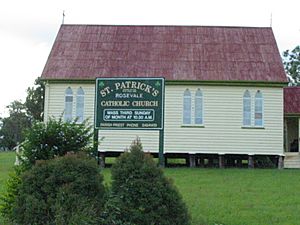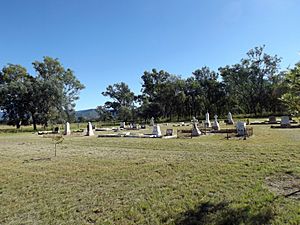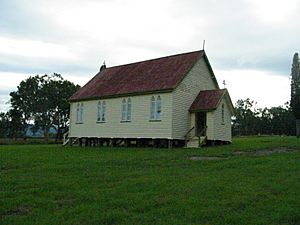St Patrick's Church, Rosevale facts for kids
Quick facts for kids St Patrick's Church, Rosevale |
|
|---|---|

St Patricks Catholic Church, Rosevale, 2006
|
|
| 27°51′01″S 152°28′43″E / 27.8502°S 152.4786°E | |
| Country | Australia |
| Denomination | Roman Catholic |
| History | |
| Status | Church |
| Dedication | Saint Patrick |
| Dedicated | 3 November 1889 by Archbishop Robert Dunne |
| Architecture | |
| Architect(s) | Father Andrew Horan |
| Architectural type | Church |
| Years built | 1888 – 1889 |
| Specifications | |
| Materials | Timber; corrugated iron; weatherboard |
| Administration | |
| Archdiocese | Brisbane |
St Patrick's Church is a historic Roman Catholic church located in Rosevale, Queensland, Australia. It was designed by Father Andrew Horan and built between 1888 and 1889. This special building is listed on the Queensland Heritage Register, which means it's protected for its historical importance.
Contents
History of St Patrick's Church
St Patrick's Church is a simple timber building in a beautiful countryside setting. It opened in November 1889 to serve the small farming community of Rosevale. This area is located south of Ipswich in south-east Queensland. The graveyard next to the church was also blessed at the same time. Both the church and graveyard are still used today, though church services are mostly for an annual mass.
Early Settlement in Rosevale
The Rosevale area began as a large sheep farm around 1846. This was during the first period of free settlement in Queensland. Over time, this large farm was divided into smaller blocks for farming. Many families moved here in the 1870s and 1880s. They were attracted by the rich farmland and the promise of a future railway line. The first settlers were mainly Irish immigrants, followed by German families.
Growing the Rosevale Community
In the 1880s, Rosevale started to grow into a real community. A school opened in 1884 with 42 students. Some businesses also came to the area, like a general store, butcher, baker, and blacksmith. Later, a cheese factory and a dairy company were also established. As more people settled, they built churches for different faiths, including Catholic, Anglican, and Lutheran churches.
The Irish Catholic Community
Irish Catholic families were among the first to farm in Rosevale. They created a "little Ireland" focused on St Patrick's Church and their Catholic faith. This strong community feeling lasted well into the 1930s.
Initially, Rosevale was part of the large Catholic parish of Ipswich. This parish covered a huge area of Queensland. In the 1850s and early 1860s, Father William McGinty held masses in people's homes in the Rosevale area. When Queensland became a separate colony in 1859, the Roman Catholic Diocese of Brisbane was created.
Father Andrew Horan's Vision
Father Andrew Horan was the parish priest of Ipswich for 44 years (1873–1917). He was very important in expanding Catholic facilities in the area. Father Horan and his brothers were nephews of James Quinn, the first Bishop of Brisbane. They all wanted to encourage Irish Catholic immigrants to settle in rural Queensland. They also aimed to build Catholic churches, schools, and other buildings across the diocese.
Father Horan served during a time when many people were moving to Queensland. He encouraged the building of rural churches throughout his parish. He also started the construction of the beautiful St Mary's Church in Ipswich and St Brigid's Church in Rosewood. He believed that strong Catholic buildings would help Irish Catholic immigrants gain respect. By 1904, he had supported the building of 14 timber churches around Ipswich, and he even designed some of them, including St Patrick's at Rosevale.
Building St Patrick's Church
Before the church was built, Father Horan would travel from Ipswich to hold mass in local farmers' homes. As the Irish Catholic community grew, Father Horan encouraged them to build their own church. In 1888, land was bought for the church. It was in a central spot among the first Rosevale farms.
The foundation stone for the new church was laid by Father Horan on 18 November 1888. An Ipswich contractor, John Madden, and his son built the church following Father Horan's plans. It was finished by November 1889. Archbishop Robert Dunne blessed the church and its altar. About 200 people attended the opening ceremony.
The church was built on a small hill west of the Bremer River. It overlooked the farming areas. It was made of hardwood weatherboards and had a corrugated iron roof. The building was 48 feet long and 28 feet wide. It had lancet windows along the sides for light and air. Inside, there were simple pine benches for seating and a "very pretty" altar. A small vestry (a room for the priest to prepare) was also part of the church. The total cost to build and furnish the church was over £400.
The Graveyard
At the opening, the Archbishop also blessed the graveyard next to the church. It was common in the 1800s for churches to have graveyards nearby. Many Catholic, Anglican, and Lutheran communities in Queensland built graveyards next to their churches.
Later Years and Changes
After the church opened, visiting priests from Ipswich held regular masses. One important priest was James Duhig, who later became Archbishop of Brisbane in 1917. He loved his time serving the Rosevale community. He saw it as a strong Irish Catholic group growing into being Australian.
In 1915, Rosevale became part of the new Rosewood parish, where it remains today. At some point, a small porch was added to the front of St Patrick's Church. In 1921–1922, the church was renovated. A new sanctuary canopy was added, and the interior walls were lined. Archbishop James Duhig, who had often visited the church as a young priest, blessed these changes in 1922. He also attended the church's 50-year celebration in 1939.
In the 1960s, some small changes were made inside the church after Vatican II. The communion rail was moved, and the altar was changed so the priest could face the congregation. Over the years, the number of local church members slowly decreased. However, families descended from the original Irish Catholic settlers still maintain the church today.
In the early 1990s, the church land was divided, and a new road was built through the property. The church kept the land south of this new road, which included the churchyard.
About St Patrick's Church Today
St Patrick's Church and its graveyard are about two kilometres north-west of Rosevale township. The church is a simple timber building built in 1889. It has a gabled roof, a small porch, and simple Gothic-style windows. The outside of the church has changed very little since it was built.
The church, graveyard, and other features are at the eastern end of a long, rectangular piece of land. This land slopes down towards the Rosewood-Aratula Road. The church itself is a single-storey timber building, about fifteen metres long and nine metres wide. It sits on timber stumps, which vary in height because of the sloping ground.
Church Exterior and Interior
The church is made of timber and covered with painted weatherboards. The roof is made of corrugated iron. There are simple wooden crosses on the roof ridge, which are some of the few decorations on the outside. A Celtic-style timber cross decorates the top of the front porch.
The main entrance is through the small timber porch. The east and west sides of the church have four sets of tall, paired casement windows. Each window has a fixed pointed-arch top. The back of the church has two doors.
Inside the church, the main door opens into a central aisle. This aisle runs through the nave (the main part of the church) towards the altar. Rows of pews are placed on either side of the aisle. Two small rooms, a vestry and a sacristy, are located on either side of the altar. The floors are made of timber boards, with a red carpet down the central aisle.
The ceiling over the nave is lined with wide timber boards painted white. You can see parts of the timber roof trusses through the lining. The walls in the nave were lined in 1922. The lower part of the walls has narrow vertical boards, while the upper part has plywood sheets. Both are stained. Framed Stations of the Cross are placed along the walls. In one corner, there is a stand-alone confessional made from dark-stained silky oak. In another corner, there is an old pedal organ. The early timber pews are made from pine and stained dark brown.
The altar is on a raised platform in the sanctuary. It is made of polished silky oak and has beautiful carvings. After changes in the 1960s, the altar was cut in half so the priest could stand behind it and face the congregation. A small statue of St Patrick sits on a ledge at the front of the altar. The arched ceiling above the altar was added in 1922.
The vestry and sacristy rooms have doors to the outside. They also have semi-circular alcove shrines built into their northern walls. One alcove holds a statue of the Virgin Mary, and another holds a statue of the Sacred Heart of Jesus. A statue of St Joseph is also nearby.
The Church Graveyard
Most of the marked graves in the church graveyard are grouped in rows. About 68 names are recorded, with dates ranging from 1887 to 2009. Burials have happened consistently since the graveyard opened, with many in the 1920s and 1930s. Headstones come in many styles and materials, some very detailed. There is an elaborately carved Celtic cross and some plots enclosed with wrought iron fences. Older headstones are often made of marble. Families are usually buried together in family plots.
In one corner of the churchyard, there are three graves marked by timber crosses and iron markers. These are believed to belong to members of the Quirk family.
From the church site, you can see wide and beautiful views of farmland and distant mountains. The church itself, with its sloping grass lawns and trees, looks very picturesque, especially when seen from the Rosewood-Aratula Road.
Why St Patrick's Church is Important
St Patrick's Church and Graveyard were added to the Queensland Heritage Register on 11 December 2009. This means they are important for several reasons:
- Showing Queensland's History: St Patrick's Church and Graveyard show how Queensland's history developed. It is especially important because of its connection to a strong Irish Catholic community. This community inspired Father James Duhig, who later became a very influential Archbishop. The Rosevale community was a successful "little Ireland" that lasted into the 1930s. For James Duhig, this community showed the success of rural Irish Catholic efforts. The church and graveyard are strong proof of early Irish settlement in Queensland.
- Showing a Type of Historic Place: St Patrick's Church and Graveyard are still very complete. They show what a simple, late 1800s rural church complex looked like. This includes the timber church building, an outdoor toilet, a fenced churchyard with grassy areas and trees, and a graveyard. The church is beautifully set on a small hill overlooking farmland. It still looks and functions much like it did in the past, making it an excellent example of its kind. The inside of the church still has most of its original items and furniture from the 1880s to the 1920s.



